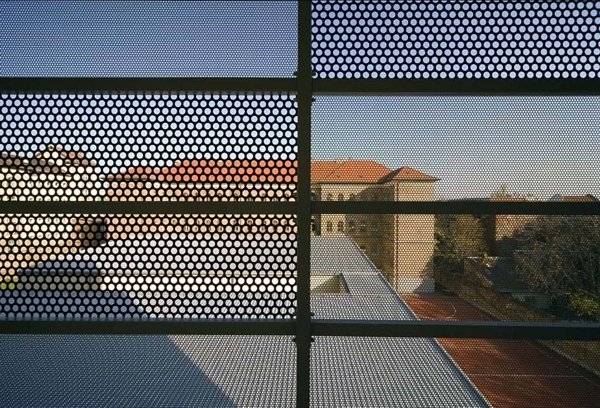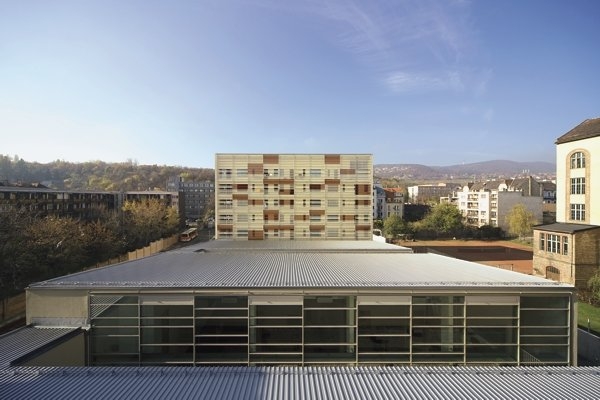With a Healthy Approach
School for the Mentally Retarded, San Marco Street
Architects: Tamás Attila Tarnóczky, Mihály Balázs
Text: Krisztina Somogyi
Photos: Tamás Bujnovszky

The capital made a decision more than six years ago to start out a construction project in an old building with a yard. This edifice had been erected to function as a hospice, later on was used as a college for a long time, so that the education and training of childen with moderate mental retardation could at last have a home it deserves. No similar institution had been completed in the past few decades. Six years later the original conception was concentrated and simplified at several points: it has a tight structure and has moved away from the slightly fashionable architectural ideal towards a logical and humane solution.
The building erected after Tamás Tarnóczky’s design winning the competition was inaugurated in September. The intention of the investor has been realized to the full: children in need of such provision can study and live in a highly demanding environment. After a tour of the institution I saw it cearly that one of the secrets of its architectural success lies in systematization: the ability to see the essence, logical talent and systematizing thinking.
On the lot a kindergarten, a primary school, a specialized trade school, children’s home, dormitory and pedagogical service had to be accommodated with gyms, a swimming-pool and occupational rooms, whilst complying with especially strict regulations of fire-protection and safety for 175 children with moderate mental retardation. The situation is indeed a complex one. Tarnóczky’s concept, however, is as simple as a formula: facing the turn-of-the-century building, a new one has been erected on the other side of the lot similar to it in size, mass and orientation. The first one is meant for education, whilst the new one houses a students’ and childrens’ home. These two buildings facing each other form the frame for the development, the constructed, artificial border of a unique world. Amongst them lower and smaller pent-roofed buildings fill in the space entirely: this is where large-size communal functions (gym, swimming-pool, dining hall) are found. The new building approaches the old one with a delicate and gentle gesture, just stepping out towards it to touch it. This engagement is rich in meanings: the architectural statements of the new and the old house separate from each other in a consistent way. During the reconstruction of the fin-de-siécle brick building the goal may have been to reinforce the majestic presence, in which the sophisticated representation of details also plays an important role. Spatial relations within the new building and the richness of light conditions attract attention to themselves. I like the way the two buildings turn towards each other. Two different types of hole-architecture are opposed here: the traditional brick architecture with facades articuleted by windows and cornices as contrasted with an enormous perforated expanse of metal that due to safety reasons border the outer corridors leading to the residential quarters. The view is defined by red surfaces placed amongst the grey components excitingly and randomly completed by tiny openings left here and there. The open corridors are integrally associated with the designer’s analysis of the situation according to which some of the children living here only step out of the building when taking a walk with their teachers, which means they actually live within these walls almost all throughout their lives. According to Tarnóczky’s logic, it is important for children to experience the changes of the parts of the day and seasons day by day: in the morning leaving their „home” in the new building they also put on their „walking-out” clothes even if it is only a corridor they have to walk along to get to school. This change of clothes is an extra task for their educators, but it is a process through which the cyclic character of time is perceptable in a natural way, the micro-world locked into the building keeps in contact with the exterior reality. In this sense the building becomes part of the pedagogical effort which also aims at the social integration of mentally handicapped children.

Viewed from the outside it is understandable that the institute is a perceptibly reserved one: located in San Marco Street a well-ordered and kept front garden pushes back the fin-de-siécle building appearing an enclosed sight towards Bécsi Road. The interior space counterbalances the impression of closedness as the definitive experience is defined by the transparencies and openings into the interior light corridors. One may ask what kind of picture this complex spatial organization could make up in the consciousness of a mentally retarded child. There is no general answer to this question, but the idea that the visual beauty offered by the building may be a source of joy for some appears loveable. As the headmistress of the institute experiences the positive impact of the clear and logical organization of spaces is already felt because children have excellently learned the routes they follow day by day: they can orientate quite well, and have also learnt to like their environment.
The personal touch is expressed in the opportunity offered by this building, but of course it is the educators who are to take the chance. The strict building designed by Tarnóczky as well as the solutions of the interior design by György Frank György may be liked just because the aesthetics of the house is an open and receptive one, so the well-ordered medium shall be able to bear several personal signs. The house does not wish to tell us anyting special about the world the mentally retarded children live in, but intends to offer scope and space to serve the individual interests and the unique world of those living there.
Client: Budapest Főváros Főpolgármesteri Hivatal, intézményvezető: Lászlóné Burján
Architects: Tamás Attila Tarnóczky – Építészkohó Kft., Mihály Balázs – Török és Balázs Építészeti Kft.
Fellow architects: Balázs Tatár, Dávid Török
Interior design: György Frank – Arma Stúdió Bt.
Structure: János Volkai – TM Janeda Kft.
Plumbing & HVAC: Zsolt Kálmán – Kálmán és Társai Kft.
Electrical planning: József Krén – Elekt-Royal Kft.
Fire protection: Zsolt Mikola – Mikola Systems Kft.
Insulations: Judit Horváthné Pintér – Pintér & Laczkovits Bt.
Garden design: Katalin Hlatky – Liget-Terv Bt.
Art historians: Alice D. Mezey, Ferenc Springer
Main contractor: IGN Zrt.







